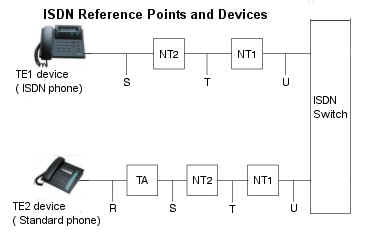Integrated Services Digital Network (ISDN), as the name implies, provides integrated services that consist of telephony, data, and video transmission over ISDN.
ISDN is of two types:
Basic Rate ISDN consists of two 64kbps B-channels (B for Bearer) and one D-channel (2B+1D). B-Channels are used for transmitting user information (voice, data, or video), and D-Channel is used for transmitting control information. B-Channel offers a bandwidth of 64kbps, and D-Channel has a bandwidth of 16kbps. With 2B channels, BRI provides up to 128kbps uncompressed bandwidth. Note that the total bandwidth used by ISDN BRI is 192kbps. The remaining bandwidth [192 - (2B+D)] or 48kbps is used for framing.
Primary Rate ISDN consists of 23 B-channels and one D-channel (23B+1D) for US or 30 B-channels and one D-channel (30B+1D) for Europe, Australia, India, and some other countries. The ISDN standard followed by Europe is also known as Euro ISDN, and standardized by ETSI (European Telecommunications Standard Institute). The PRI D-Channel offers 64kbps bandwidth.
There are several constituent standards that define ISDN.
I.430 Standard: It describes the Physical layer and part of the Data Link layer for BRI.
Q.920 and Q.921 Standards: Together, they provide the Data Link protocol used over the D channel.
Q 930, and Q.931 Standards: Documents the Network layer user-to-user and user-to-network interface. The functionalities offered include call setup and breakdown, channel allocation, and other optional services.
G.711 Standard: It describes the standard 64 kbps audio encoding used by telcos.
ISDN Reference Points:
ISDN standards specify several reference points that functionally separate the ISDN network. The ISDN devices need to comply with applicable reference point specifications. For example, a TE1 device such as an ISDN phone or a computer need to comply with reference point 'S' specifications. Various reference points specified in ISDN are given in the figure below:

R: This is the reference point between non-ISDN equipment and a Terminal Adapter (TA).
S: This is the reference point between user terminals and Network Termination Type2 (NT2).
T: This is the reference point between NT1 and NT2 devices.
U: This is the reference point between NT1 devices and line termination equipment of the Telco
Disclaimer: Simulationexams.com is not affiliated with any certification vendor, and Sim-Ex™ Practice Exams are written independently by SimulationExams.com and not affiliated or authorized by respective certification providers. Sim-Ex™ is a trade mark of SimulationExams.com or entity representing Simulationexams.com.CCNA™ is a trademark of Cisco® systems